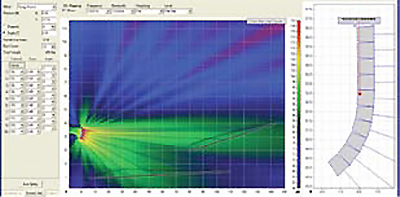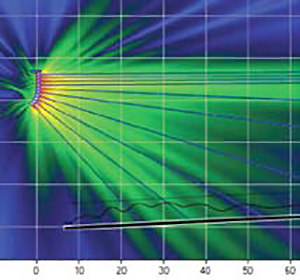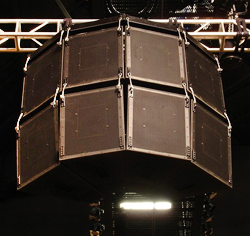It wasn’t too many years ago that most shows were supported with trapezoidal point-source loudspeakers that were either horn loaded or front loaded.
There were numerous touring companies providing proprietary loudspeaker systems, some well engineered and some not so well. Rigging was often an afterthought, and many systems were ground stacked. Companies sprang up that did nothing but design and build aftermarket flying hardware to support both proprietary and manufacturer loudspeakers.
Depending on the combination of rigging and loudspeakers, the desired coverage might or might not be attained; we might or might not be able to get the exact coverage we were looking for, but because of the nature of point-source, a high level of precision was not required.
Point and shoot was the order of the day. Eventually most of the manufacturers caught on and started producing fairly capable touring systems with rigging hardware included.
Then came the line array craze.
Line arrays only work properly with precise aiming and rigging. All of the components must be vertically stacked and spaced within about one-quarter of a wavelength at the frequency of interest to couple and produce the desired “cylindrical” wave front. The splay between cabinets in the vertical domain has a large effect on how the array behaves. Point and shoot will not work.
The potential to create unwanted lobes and nulls in the coverage pattern requires a fairly sophisticated modeling program to predict the array behavior accurately. Some systems offer amplitude and frequency shading options.
They also require rigging hardware that is precisely adjustable in single or even fractional degrees. Inclinometers and lasers have become part of the rigging toolkit.
Out Of Reach
Except for the very largest touring companies the engineering resources to create “home brewed” line array systems are simply not available.
The CNC machines necessary to do complex wood and metal work are not in the inventories of most sound companies. Computer programming and software creation are not in most of our skill sets.
There are some prediction software “shell” programs that will accept data from a “one-off” loudspeaker, but the designer must also have the facilities and equipment to provide accurate and complete testing data not to mention paying a licensing fee to the software company. That puts line array development out of reach for most of us.
In many ways this is not a bad thing. From a provider point of view, a variety of quality solutions are available. As front of house mixers, most of us are familiar with many of the commercially produced systems out there, and this makes show advance much more predictable. Rigging is certainly safer. (And the loudspeaker manufacturers like it too!)
But maybe the pendulum has swung too far in the line array direction. Most of the major manufacturers offer many more line array products than large concert-level point-source devices. Few seem to be spending R&D dollars to develop new point source loudspeaker systems capable of doing major show reinforcement.
The bigger touring providers and many regional reinforcement companies have line arrays as their primary systems. Even riders for clubs and small theater shows list line arrays as their preferred equipment. Yet while line arrays are very effective tools for certain applications they’re not a “one size fits all” solution by any means.
The Upside
First, let’s look at what they do well. Line arrays are by far the best solution for festivals and other large-scale outdoor events.
We can hang extremely long arrays in most cases and this pushes the coverage back to a distance where we may not even need delay towers, except for the very largest crowds.
Skipping delay towers means that we don’t have to run power and line level signal through or around the main crowd area to reach the scaffolding. We don’t need to set delays and recheck and realign them as the temperature changes through the day and night.
Typically, there is enough trim height so that bass arrays can also be long enough to behave in true line array fashion down to a very low frequency. Vertical dispersion can be controlled to minimize community noise issues.
Line arrays also work quite well in large arenas or “concrete boxes” with poor acoustics. The audience areas can be covered well using the precise aiming and pattern control capabilities of the array to minimize interaction with the room.
“Don’t excite the beast!” as a friend of mine puts it. Even rooms with ridiculous reverb signatures can be made usable with a properly implemented line array.
Line arrays also provide advantages for speech-only reinforcement. Political events, comedians and corporate presentations make up a steady chunk for many sound companies.
Line arrays don’t have to be very long to provide good performance through the speech range. A 200 Hz wavelength is only about 5 feet long, and since this is as low as most human speech fundamentals go (usually a little lower for men, a little higher for women), there’s no need to hang a long array to get the benefits of longer throw and less room interaction.
Complicating Factors
Now let’s review some of the limitations that make line arrays a less desirable choice for certain events.
The physics of how they work has been very well documented in other places, so I won’t reiterate it here. But the key to their behavior lies in the interaction between the adjacent boxes in the array. This means that in order to get even SPL coverage at any given frequency, the array must be very carefully splayed. This cannot be done by the seat of the pants.
To get optimum results in any venue we must break out the laptop and do a model of the space and the hang to avoid hot spots and dead zones. Line array manufacturers all supply variants of this software. Figure 1 shows an example.

The disadvantage here is that we must model every room if we’re using a line array. Point and shoot absolutely will not work. The hang also has to follow the prediction model faithfully in both location and angle. This can be time consuming, and time is usually not our friend on show days.
Line arrays and ground stacking do not generally play well together. It’s difficult or even impossible to achieve the desired angles and coverage with a fixed base at a fixed height. With arrays stacked on a stage, there is a strong tendency to have most of the energy passing over the heads of the audience.
Further, if there’s a flat back wall or a balcony face, the problem is even worse. The fact that we only lose 3 dB per doubling of distance, instead of 6 dB, means that we’re hitting these boundaries much harder than a point source would—and the slap back can be surprisingly nasty. (These issues also apply to a lesser extent to rooms with low ceilings.)
No Free Lunch
Line arrays do a very good job of creating equal SPL from the front to the rear of an audience area. But there is NFLIA (No Free Lunch In Audio). They do a much poorer job of creating equal frequency response at different distances.
Because of the complex relationships that make up a line array, their behavior is very frequency dependent. Factors including cabinet splay, driver spacing, angle to the listener, array length versus frequency, and horizontal spacing of the components all cause frequency response variations in the listening area.
Different parts of the array cease to exhibit line array behavior and revert to point source behavior at different distances. If you don’t like the way it sounds where you are, try moving 20 feet forward or backward!
In the area close to and directly below an array, there are even more frequency anomalies than farther away. Because the listeners are at a severe vertical angle perpendicular to the array, driver spacing becomes problematic. It creates nulls and lobes below (and above) the array.
In a festival situation the audience is generally kept away from the front of the stage, but in a theater situation the front rows are the expensive seats. Look at what is happening in Figure 2. The black line is the amplitude at 2 kHz. Remember that these peaks and nulls will propagate off the ends of the array at all frequencies above a certain cut off, but they will change location and amplitude.

Aspects To Consider
Point source boxes have limitations as well, but they also have some benefits. We can ground stack effectively and get reasonable coverage without resorting to a laptop.
A well-designed horn-loaded box can give excellent pattern control in both the horizontal and vertical planes. Although their SPL coverage drops more, their frequency response tends to be more uniform with distance.
System scalability is another advantage. Point source systems are more effectively broken up into multiple smaller systems.
We can use just the number of boxes required for coverage in a given venue rather than have the array size be governed by the physics of frequency versus pattern control. Low ceilings and reflective rear walls are less of a problem.
Please don’t get the wrong idea—I’m not suggesting that everyone pile up their line arrays in the parking lot and put a match to them. They’re a great tool. Ever hear the old story about a roadie using a certain microphone to pound nails into the drum riser? Sure, the nails got pounded, but maybe a hammer would have been a better choice of tool.
For companies looking to add to their loudspeaker inventories, I’m merely saying that rather than reflexively adding line array cabinets, it’s probably a good idea to first take a hard look at the type of venues they’re supporting and consider whether a point source direction might be a better addition to the tool box. Horses for courses.















